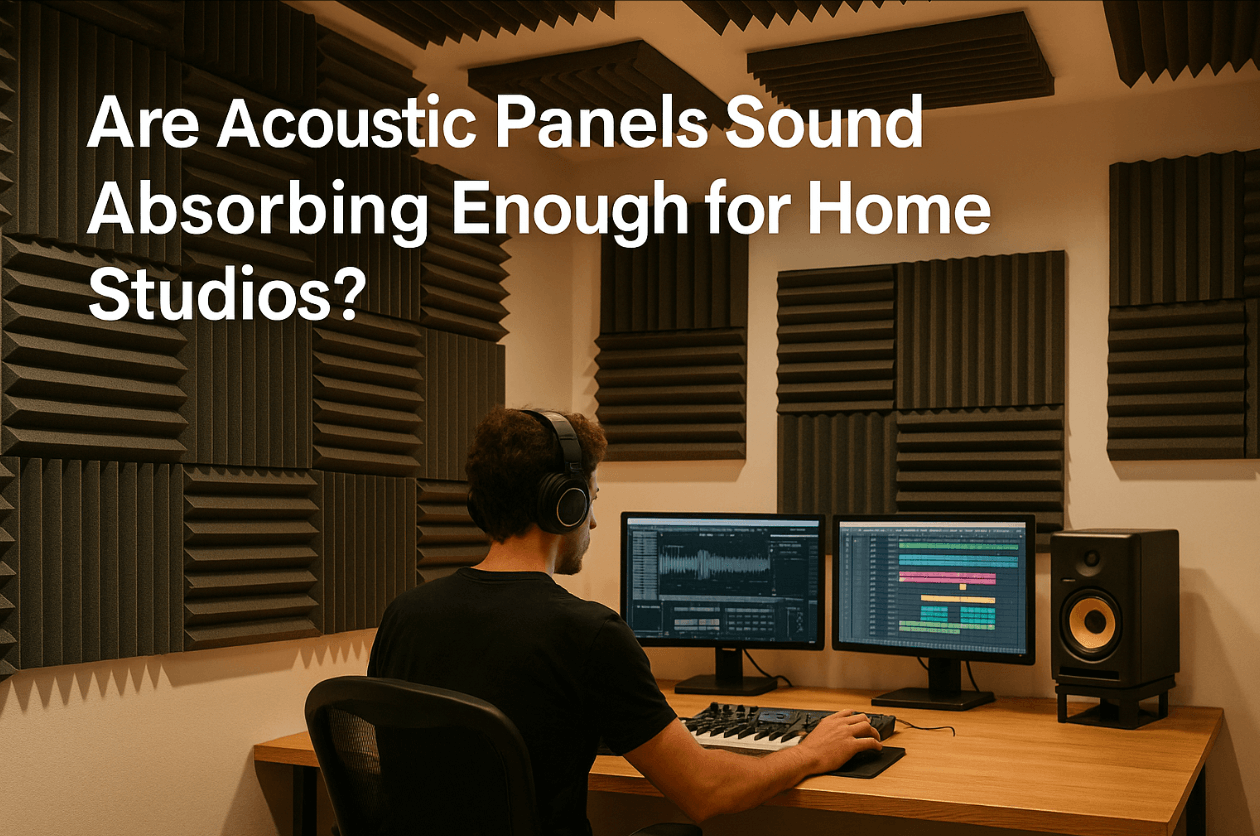Are Acoustic Panels Sound Absorbing Enough for Home Studios?
Ever spent hours polishing a track only to hear a boomy mess when you play it elsewhere? That problem usually isn’t your gear—it’s the room. Acoustic panels sound absorbing devices tame reflections and flutter echoes so your mixes translate. Unlike mass‑loaded barriers that block noise, these panels “drink up” excess energy and flatten the response curve.
Whether you’re treating a bedroom or building a turnkey studio, sourcing materials matters. Wellco Wholesale supplies factory‑direct acoustic and building products in bulk—gardeners, contractors, and audio pros alike tap the company for consistent quality without retail mark‑ups. This guide walks you through choosing, sizing, installing, and budgeting panels so you get pro results the first time.

Understanding Home‑Studio Acoustics
Why Small Rooms Create Big Acoustic Problems
Most spare rooms are rectangles with drywall and glass—hard, parallel surfaces that trap energy. In a 12 m² bedroom the untreated reverberation time (RT60) often sits between 0.7 s and 1.0 s, well above the 0.3‑0.4 s target for critical listening. Early reflections smear stereo imaging, and standing waves exaggerate bass at the mix position.
How Sound‑Absorbing Panels Work (NRC, density, thickness)
Panels work by forcing air molecules through a porous core—usually fiberglass, mineral wool, or high‑density foam—turning kinetic energy into heat. A lab‑tested 2″ 6 pcf mineral‑wool board carries an NRC of 0.95, meaning it absorbs 95 % of incident mid‑band energy. Thicker panels shift absorption deeper into bass territory, but material density also plays a role: overly dense boards reflect instead of absorb.
Choosing the Right Acoustic Panels Sound Absorbing
Core Materials Compared: Fiberglass vs. Mineral Wool vs. PU Foam
| Core | Typical Thickness | Weight lb/sq ft | NRC (2 kHz) | Notes |
|---|---|---|---|---|
| Fiberglass 3 pcf | 2″ | 0.75 | 0.90 | Light, economical |
| Mineral Wool 6 pcf | 2″ | 1.00 | 0.95 | Better low‑mid control |
| Polyurethane Foam | 2″ | 0.35 | 0.70 | Lightweight, lower fire rating |
Independent lab tests (Riverbank & Orfield) show mineral‑wool outperforming foam by ~30 % below 250 Hz.
Fabric Wraps & Finishes that Blend with Décor
Acoustic fabric must be breathable (< 90 Pa s/m² airflow resistivity) and meet ASTM E84 Class A fire codes. Designers favor open‑weave polyester because it comes in dozens of colors yet doesn’t degrade absorption. “A neutral gray panel almost disappears under proper lighting,” notes interior acoustician Maria Gómez.
Specialty Panels: Bass Traps & Diffuser‑Hybrid Units
Broadband traps—thicker blocks placed in corners—go after 40‑125 Hz modes that thin panels miss. Hybrid units combine a slatted wood face with mineral‑wool backing, scattering mid/highs while absorbing lows. In a streamer’s attic studio, four 4″ bass traps dropped seat‑position boom by 7 dB, letting him mix dialogue without headphones.
How Many Panels Do You Actually Need?
Simple RT60 Target Method (Math Walk‑Through)
-
Measure room volume: L × W × H. Example: 4 m × 3 m × 2.5 m = 30 m³.
-
Choose target RT60: 0.35 s for near‑field mixing.
-
Apply Sabine: A = 0.161 V / RT60 → 0.161 × 30 / 0.35 ≈ 13.8 m² of absorption.
-
Divide by panel face area (0.6 m × 1.2 m ≈ 0.72 m²) → 19 panels.
Panel Placement Priorities
-
First reflections: side walls at ear height.
-
Ceiling cloud: above desk to trap vertical flutter.
-
Corners: stacked traps for modal control.
-
Rear wall: diffuse or absorb to taste.
Mini Case Study: 12 m² Bedroom Studio Treatment
A hobbyist producer installed 14 broadband panels and two corner traps. RT60 fell from 0.82 s to 0.32 s, and he reports, “I finally trust my low‑end decisions—mixes translate to the car without tweak‑paralysis.”
Installation Best Practices
DIY Mounting vs. Z‑Clips & French Cleats (Pros & Cons)
-
Picture‑wire hooks: cheap, fine for foam; sag with dense panels.
-
Z‑clips: metal interlocking strips; hold 50 lb and sit flush.
-
French cleats: plywood bevel strips ideal for modular layouts.
Safety: Fire Codes, Off‑gassing, and Handling PPE
Wear nitrile gloves and an N95 mask when cutting fiberglass or mineral‑wool boards. Check local code; most municipalities demand Class A surfaces for commercial spaces.
Maintaining Panel Performance Over Time
Vacuum fronts quarterly using a soft brush. For fabric sag, lightly mist with warm water and stretch. Keep humidity < 60 % to avoid binder breakdown.
Budgeting & Sourcing Panels
Cost Benchmarks (Per‑Panel & Per‑Square‑Foot)
-
Retail 2″ wrapped fiberglass: $70–$85 each (≈ $14 ft²).
-
Bulk raw boards + DIY fabric: $35–$45 each (≈ $7 ft²).
-
Corner traps 4″: $120–$150 retail.
Wholesale Advantages for Creators & Integrators
Ordering pallet quantities trims freight and unit costs. Wellco Wholesale ships mixed loads of acoustic, garden, and light‑build supplies—ideal for integrators fitting out multiple rooms. Minimum order quantities start at 50 panels; larger drops qualify for free LTL delivery to most U.S. hubs.
ROI Snapshot: When Treatment Beats Gear Upgrades
Producer “Lena K.” spent $600 on treatment after years of chasing microphones. “That single spend improved clarity more than my $1 k condenser ever did,” she says, underscoring why room first, gear second is the enduring mantra.
Conclusion
Identify the acoustic problems, pick materials that match your frequency targets, calculate square footage scientifically, install with safety and precision, then buy smart to stretch the budget. Ready to banish muddy mixes? Request a bulk quote from Wellco Wholesale and outfit your studio with high‑performance acoustic panels sound absorbing today.
Frequently Asked Questions
Q1: Do I need bass traps if I already install standard 2″ panels?
Standard panels help the mids and highs, but low frequencies linger in corners. Adding thicker bass traps (4″+) in at least two corners cuts those boomy modes dramatically.
Q2: Can I paint or wallpaper over acoustic fabric?
Paint and wallpaper block airflow, ruining absorption. Instead, choose a colored acoustically‑transparent fabric or order custom wraps.
Q3: How long does installation take for a typical bedroom studio?
Expect 2–3 hours for measuring, marking first‑reflection points, and mounting 15–20 panels with Z‑clips; most of that time is precise placement.
Q4: Will panels eliminate outside noise from neighbors?
No. Absorbers control reflections inside the room. To block external noise you need isolation solutions such as mass‑loaded vinyl or double‑wall construction.
Q5: What’s the lifespan of mineral‑wool panels?
Indoors and kept dry, they easily last 20 years. Periodic vacuuming maintains appearance, and fabric can be re‑wrapped if styles change.

